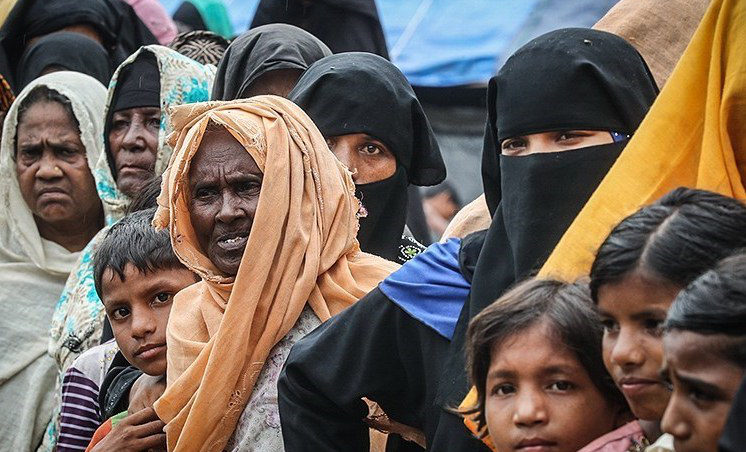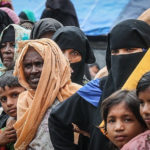Can Anything Justify the Plight of the Rohingya Refugees?

The Rohingya refugee crisis was identified by the United Nations officials as the fastest growing refugee crisis in the world in 2017. More than 600,000 Rohingya refugees have crossed from Myanmar into Bangladesh and now live in shanty-like refugee camps in Cox’s Bazar, which is located in south-eastern Bangladesh. Bangladesh shares a 271-kilometer border with Myanmar and 54 km of this long stretch of border is a riverine border on the southeastern edge of Bangladesh. The Rohingya refugees have been entering Bangladesh through various points on this border and the influx of Rohingya refugees has not stopped yet.1
It is not for the first time that Rohingyas have fled to Bangladesh. It is claimed that attacks on Rohingyas have been going on since 1978, i.e. for more than four decades. The situation of Rohingyas in Myanmar started to deteriorate in 1974 when the National Registration Certificate was introduced in Myanmar. Gradually Rohingyas started to lose their rights and eventually their status as citizens have also become diluted since 1974. Rohingyas were previously considered an indigenous race and were also given representation in parliament in Myanmar from 1948 till 1961. Shortly after the introduction of the National Registration Certificate, a campaign was launched in 1977 to identify “foreigners“. This campaign was known as the Nagamin Campaign or Operation Dragon King. And thus in 1978, the first exodus of Rohingyas to Bangladesh took place.2 It is claimed that since 1978, Rohingyas have fled to Bangladesh on five occasions. However, the latest round of exodus that began on August 25 last year is alarming as the influx of Rohingyas to Bangladesh still continues.
What is intriguing in the Myanmar case is that many justifications have started to come up after the Rohingya refugee crisis made headlines worldwide. One can easily understand the plight of refugees who are fleeing to some other country to save their lives. And, thus, one could become critical of the conduct of the state of Myanmar. I was amazed by the justifications forwarded by some as to why Rohingyas have meted such a fate. Can any sort of reasoning justify the plight of thousands of Rohingya refugees?
Stories abound regarding the torture and violence that the Rohingyas were subjected to in Myanmar, and they clearly point to the gruesome clearance operations of the Myanmarese forces. According to Human Rights Watch, the attacks on Rohingyas by the Myanmar Army has led to the disappearance of more than 288 Rohingya villages.3 There are several accounts of houses of Rohingyas being brought down using rocket launchers. Many refugees claim that they lost their family members in such attacks.
However, for most, the reasons behind such hatred and violence against the Rohingyas in Myanmar remain unclear. This is especially so because the people in Myanmar have for a long time been seen as peace-loving people suffering under a violent regime. No-one could have imagined or predicted such a turn of events where the transition from an authoritarian regime led not to democracy but the radicalisation of its civilians and aggressive attempts to rid the country of those who are believed to be outsiders. Moreover, since ninety percent of the population is Buddhist, it becomes more difficult to understand the violent episodes of ethnonationalism that has gripped Myanmar.
According to some accounts, Rohingyas are viewed skeptically in Myanmar as they sided with the British during Myanmar’s struggle for independence as well as demanded accession to East Pakistan (now Bangladesh) in 1947.4 It is claimed that Myanmar has suffered for a long time because of Rohingya insurgency in Western Myanmar, i.e. Rakhine state which borders Bangladesh. It is contended that local mujahideen groups attempted to secede from the Rohingya populated areas, in the northern Rakhine state from Myanmar and accede it to East Pakistan (present-day Bangladesh).
I also came across various other accounts attempting to explain the reason for the hatred and torture carried out against the Rohingyas in Myanmar. According to some accounts, Rohingyas were involved in carrying out violence against the Buddhists in the regions populated by the Rohingya in Myanmar. Such episodes of violence ultimately led to communal riots between Rakhine Buddhists and Rohingyas, which resulted in the death of many Rohingyas.5 The situation became more severe when Rohingyas allegedly started attacking and killing Buddhist monks. And since then, Buddhist monks have also started to openly side with the civilians against Rohingyas.
It is claimed that the real situation on the ground is not a one-sided massacre but a violent conflict between different communities, especially between those having different religious or ethnic identities with losses of human life on both sides. Both Rakhine Buddhists and Rohingyas have suffered in this whole episode of violent events that have engulfed Myanmar. Another reason forwarded for the exclusion of and hatred against Rohingyas is that Rohingyas have been involved in proselytism but in Myanmar, there is very low tolerance towards proselytism.6 Many pro-Myanmar accounts assert that Myanmar is not at all engulfed in any kind of violent ethnonationalism, as other minority religious communities, such as Christians and Hindus, have never faced violence from the majority Buddhist population. However, it is the Rohingyas who created trouble in Myanmar and they now face the wrath of the Buddhist civilians.
Whatever the reasons for such violent operations against a minority community in Myanmar, such atrocities are a clear violation of human rights and a crisis which has to be addressed by the Myanmar government. Retributive justice can never be a solution in any civil conflict. It just breeds hatred and further violence. It is the responsibility of the government to intervene and create an atmosphere of peace and stability in case the situation of Rohingyas are a result of a violent civil conflict between different communities, as is alleged by many pro-Myanmarese accounts.
_
1 https://news.sky.com/feature/rohingya-crisis-11121896
2 https://www.frontline.in/world-affairs/escape-from-terror/article10008265.ece
3 https://www.frontline.in/world-affairs/escape-from-terror/article10008265.ece
4 https://www.frontline.in/world-affairs/escape-from-terror/article10008265.ece
5 http://www.vedicupasanapeeth.org/news_inter_67774_mya/
6 https://www.google.co.in/amp/s/amp.cnn.com/cnn/2017/11/25/asia/myanmar-buddhist-nationalism-mabatha/index.html
Credits
| Image | Title | Author | License |
|---|---|---|---|
 |
Rohingya_displaced_Muslims_02 | Seyyed Mahmoud Hosseini | CC BY 4.0 |
